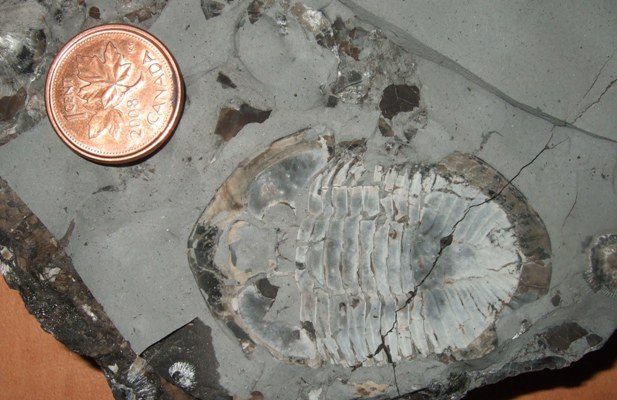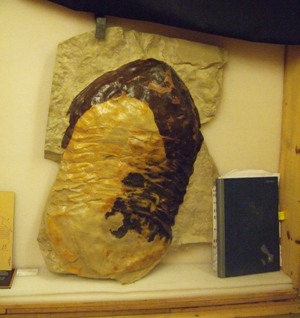

Pseudogygites latimarginensis. I believe the species was called canadensis, but this has since been subsumed. They're from the late orovician Craigleith shale, outcropping at Delphi point, Craigleith, in Ontario, Canada.
A lot of people will know what these are: they're trilobites - the masters of the Paleozoic seas. For 300 million years, trilobites reined supreme, right from the Cambrian until they met their final demise in the end-Permian extinction; the most vicous mass-extinction of all time, when the Earth literally nearly died.
Trilobites are the poster child for invertebrate paleontology. Finding a trilobite is one of those magical things that connects you with a time long past - in this case, the Ordovician, when there was next to no life on land, and when fish were just rare oddities in an ocean dominated by invertebrates. Perhaps its their age, perhaps its their beauty, but they really are incredible things.
The vast majority of trilobites are about the size of my trilobites above, and in general, smaller, because they need to moult their exoskeleton to grow larger. But, they can get bigger. Much, much bigger, as it turns out!
I think I mentionned last week that I was working at the Royal Ontario Museum. In the collections store where I've been working today, I couldn't help noticing a couple of their recent acquisitions. The first is this slab,

It doesn't get much cooler than that! My notebook is A4 sized. Here's a close-up of one,

Xenasaphus devexus, from the mid Ordovician of Russia
So, pretty big, right? Each one is about the size of a gerbil, which makes them larger than the largest beetles today (trilobites are distant relations, as arthropods). But round the corner were some even bigger ones...


Acadoparadoxides briareus, from the Cambrian of Morocco.
At ~40cm long, these guys are way, way bigger than any trilobites I've seen. But the best was yet to come, because just behind this slab, hidden behind a sheet, was this beast...

It is Isotelus rex, the largest complete trilobite ever found, and at 70cm long, it looks like it could have bitten my hand off no problem. It was found by Dave Rudkin of the ROM in Manitoba in 2003.
How does something get so big? Arthropods in particular are faced with many problems when getting big. They are limited by the strength of their exoskeleton, their need to moult to get larger, their difficulty in getting oxgen to their tissues, among many other reasons. This is not to mention the difficulty in being able to hunt enough food and to be able to interact with members of your own species.
In modern day oceans, gigantism most commonly occurs either in abyssal gigantism (i.e. deep sea), or most markedly, due to polar gigantism (known as Bergmann's Rule),

Upper data is for madagascar, lower for lake Baikal, Siberia. Please note that it is no longer thought that high oxygen levels is the main cause of gigantism in polar waters.
I. rex flies in the face of both of these epithets. Manitoba at the time was close to the equator, so there goes our polar gigantism. We can also pin point the location in the sea, because the area I. rex was found in is one of the most spectuacular examples of an exhumed coastline. It so happens that I. rex was found in a very shallow part of a shallow carbonate rich sea, similar to the Persian Gulf today.
A better hypothesis (it could really do with being tested, if there are any invertebrate zoologists reading!) is that gigantism in biomineralizing arthropods has more to do with CO2 concentration. Trilobites, like crabs and other crustaceans, calcify their exoskeleton. To do this, they absorb calcium carbonate from the oceans, whose concentration is dictated by the amount of gaseous CO2 (which, incidentally, is one reason to be worried about global warming), which was higher in the Ordovician. Perhaps the more toasty conditions at the equator at this time combined with an even greater excess of carbonate meant that I. rex could have a fast metabolism and zip through its life stages. (It must be said, though, that modern day giant crustaceans don't really corroborate this as a rule of thumb).
One thing's for sure though, and that's that it took a long time to get this big. I. rex started out as a planktonic larva, and may have began about the size of a grain of salt. If we assume Przibram's law for the proportional increase in size of the arthropod after each moult, (moult length x cube root of 2), between 10mm and 720 mm, there would have been at least 18 or 19 moults. Comparing this to moden day crabs and lobsters, this means that I. rex would have have to have been around 20 years old to reach this size. And remember that the days were only 21 hours long back then - so that's ~420 days in each year that I. rex lived through.
Whatever way I. rex managed to maintain its gigantism, we generally think of gigantic size as equating with success. Cope's rule states that as a group evolves, its size tends to get bigger and bigger, and so I. rex sits pretty as the most successful trilobite ever, if you apply this logic. In fact, I. rex is an extreme example of its entire genus, which all got progressively large during the late Ordovician.
However, the late Ordovician was the Isotelines' swan song. The entire genus - I. rex included - was wiped out in the chilly end-Ordovician extinction. This extinction was second in severity only to the end-Permian extinction 200 million years later, in terms of marine life, which wiped out the trilobites in their entirity. But, in the Permian, the trilobites had already been dethroned, and had only really been bit-players for the last 100 million years or so, whereas, the end-Ordovician extinction hit the Isotelines in their hey-day. Most intriguingly of all, though: most trilobite groups sailed straight through the event, (though admittedly, thoroughly shaken), in stark contrast to the Isotelines, who all completely disappeared. What went wrong for the Isotelines?
Its tempting to think that the Isotelines were punished for reaching excess; that they were the easy victims of a global ice age because of their decadent and demanding size constaints. Yet, this is almost certainly not the case. They were most likely wiped out because of something that seems rather innocuous, and that is their larvae.
As I mentioned above, unlike most other trilobites, Isotelines produce a myriad of tiny, plankonic larvae - ideally suited to rapidly dispersing your larvae in warm waters. This strategy was used by all the Asaphidae (to which the Isotelines belong), as well as the Cyclopygidae, Nileidae, and Trinucleoidea, all of which lived near the equator. However, come the end-extinction; sea levels drop and the sea becomes very chilly. Trilobites that produced a relatively small number of large, nutrient-rich eggs and released benthic larvae as a more adult stage of maturity through direct development, viviparity, and/or brooding, were fine. None of the Asaphidae (to which the Isotelines belong), Cyclopygidae, Nileidae, and Trinucleoidea, which produced early planktonic larvae, survived past the Ordovician.
But I guess, that's the way it goes. I. rex had it's day, and in the Silurian, the eurypterids took up the torch as the largest arthropods. Today, the current bearer of the torch is the japanese spider crab. I. rex certainly pushed the boundaries of size for trilobites, and many think its unlikely that we will ever find one larger. Although... it has been rumoured that there fragments have been found that implies that there could have been trilobites even bigger - maybe up to a staggering couple of metres. All we need to do now is find them...
------------
Thanks very, very much to Dave Rudkin for letting me see these things, and even more importantly, letting me blog about them!
Citations
- David M. Rudkin et al., “The World’s Biggest Trilobite: Isotelus rex New Species from the Upper Ordovician of Northern Manitoba, Canada,” Journal of Paleontology 77, no. 1 (January 1, 2003): 99-112.
- Gauthier Chapelle and Lloyd S. Peck, “Polar gigantism dictated by oxygen availability,” Nature 399, no. 6732 (May 13, 1999): 114-115.
- C. Jaco Klok, “O2 Levels May Not Determine Gigantism,” Journal of Experimental Biology 212, no. 7 (April 1, 2009): iv.
*******************************
As requested, here are a couple of other photos of I.rex.

(apologies for touching, if anybody from the ROM is reading...)
Here's a montage of the field group excavating the fossil, in 1998.






Comments